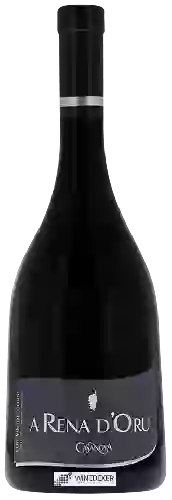
Winery Les Vignerons d'AghioneCasanova A Rena d'Oru Rouge
This wine generally goes well with
Wine flavors and olphactive analysis
On the nose the Casanova A Rena d'Oru Rouge of Winery Les Vignerons d'Aghione in the region of Corsica often reveals types of flavors of oaky, blackberry or oak and sometimes also flavors of black fruit.
Details and technical informations about Winery Les Vignerons d'Aghione's Casanova A Rena d'Oru Rouge.
Discover the grape variety: Nielluccio
The black Nielluccio is a grape variety originating from Italy. It produces a variety of grape specially used for the elaboration of wine. It is rare to find this grape to eat on our tables. The black Nielluccio can be found in several vineyards: Provence & Corsica, South-West, Cognac, Bordeaux, Languedoc & Roussillon, Rhone Valley, Loire Valley, Savoie & Bugey, Beaujolais.
Last vintages of this wine
The best vintages of Casanova A Rena d'Oru Rouge from Winery Les Vignerons d'Aghione are 2017
Informations about the Winery Les Vignerons d'Aghione
The Winery Les Vignerons d'Aghione is one of of the world's greatest estates. It offers 90 wines for sale in the of Vin de Corse to come and discover on site or to buy online.
The wine region of Vin de Corse
Vin de Corse (or simply "Corsica") is the Generic name for Corsica, an island located in the Mediterranean between France and Italy. Although much closer to the Italian coast - and separated from Sardinia only by the narrow Strait of Bonifacio - the island has been under French rule since 1769. The Vin de Corse appellation includes several sub-regions, corresponding to five major wine-producing areas of Corsica: Porto-Vecchio, Figari, Sartene, Calvi and Cap Corse. The other places, Patrimonio and Ajaccio, are also Part of the general catchment area of Vin de Corse, but have their own appellations since 1968 and 1984 respectively.
The wine region of Corsica
Corsica is an island in the Mediterranean Sea, located between the southeast coast of Provence and the west coast of Tuscany. Although it is closer to Italy, Corsica has been under French rule since 1769 and is one of the 26 regions of France. The island's Italian origins are evident in its wines, which are mainly made from the classic Italian Grapes Vermentino and Sangiovese (known here as Rolle and Nielluccio respectively). Despite its remoteness, Corsican winemakers have amassed an impressive and diverse portfolio of grape varieties - there are very few places on earth where Pinot Noir, Tempranillo and Barbarossa grow side by side.
News related to this wine
Chablis wines in the Hong Kong market by Debra MEIBURG
On December 10, 2020, four Hong Kong personalities discussed Chablis wines on a live webinar: Yang LU, Master Sommelier and Official Bourgogne Wines Ambassador, Debra MEIBURG, Master of Wine, Ivy NG, Official Bourgogne Wines Ambassador and Rebecca LEUNG, wine expert. In this minute-long clip, Debra MEIBURG discusses the position of Chablis wines in the Hong Kong market. #Chablis #PureChablis ...
At the heart of the terroirs of Mâcon-Vinzelles
Sequence from the video « At the heart of the Mâcon terroir » which offer a stroll at the heart of the Mâcon terroir. It offers a focus on Mâcon-Vinzelles, one of the 27 geographical denominations of the Mâcon appellation. Travel through the terroirs of the Mâcon appellation by watching the full video : https://www.youtube.com/watch?v=GF20y1aBZh8 Both are available in French and English. Our social media: Facebook: https://www.facebook.com/BourgogneWines Twitter: https://twitter.com/BourgogneW ...
What style should one expect from a good Chablis by Debra MEIBURG
On December 10, 2020, four Hong Kong personalities discussed Chablis wines on a live webinar: Yang LU, Master Sommelier and Official Bourgogne Wines Ambassador, Debra MEIBURG, Master of Wine, Ivy NG, Official Bourgogne Wines Ambassador and Rebecca LEUNG, wine expert. In 80-second clip, Debra MEIBURG answers the question of an Internet user : what style should one expect from a good Chablis ? #Chablis #PureChablis ...
The word of the wine: Sulphating
Treatment, formerly practiced with copper sulfate, applied to the vine to prevent cryptogamic diseases.














